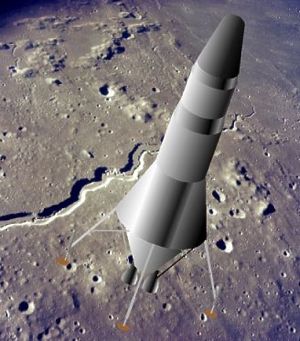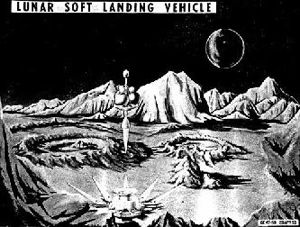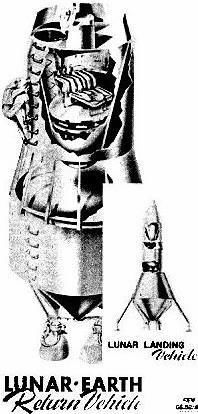
Home - Search - Browse - Alphabetic Index: 0- 1- 2- 3- 4- 5- 6- 7- 8- 9
A- B- C- D- E- F- G- H- I- J- K- L- M- N- O- P- Q- R- S- T- U- V- W- X- Y- Z
Horizon LERV
 Horizon LERV Lunar landing and return vehicle, 1959 Credit: © Mark Wade |
Status: Study 1959.
The operation in earth orbit was principally one of propellant transfer and was not as assembly job. First the third stage of a Saturn II with a lunar landing and return vehicle attached would be placed into an earth parking orbit. The third stage of the Saturn II would have expended its propellants to achieve this orbit. This stage would be refueled in orbit from subsequently-launched Saturn II third stages by a crew of approximately ten men after which the fuelled vehicle would then proceed on to the moon.
Using this orbital refueling system, individual payloads of 22,000 kg could be soft-landed on the moon. This value represented the approximate minimum weight required for a complete earth return vehicle, which was already assembled and loaded with propellants and was capable of returning several men. Thus, in order to provide a pre-assembled return vehicle on the lunar surface during the short time frame under consideration for the Horizon project, it was mandatory to go through such an initial earth refueling process. In addition to providing a large individual payload capability, the orbital transportation system offered other important advantages. Among these were that the total number of firings to deliver the same amount of payload to the moon was less and payloads could be fired for orbital rendezvous at any given pass every day of the month. This alleviated the launch site scheduling problems which were associated with the restricted firing times of direct flights.
There were two versions of the lunar landing vehicle. The first type was to be used for direct trips from earth to the lunar surface. This vehicle had a gross weight of 11,860 kg and could soft-land some 2,700 kg of payload. The second vehicle would be used for flights via refueling in low earth orbit. It would have a gross weight of 64,000 kg which gave it a capability of soft landing approximately 22,000 kg of payload on the moon. Each type of vehicle would had suitable payload compartments to accomplish different mission requirements. For return vehicle payloads, the structure of the expended braking stage would serve as a launching platform when it was time to begin the return journey to earth.
To sustain the orbital station crew and to provide for their safe return to earth, an orbital return vehicle was provided. This vehicle could be used in conjunction with another established United States orbital station, or it could be used as a basis for a minimum orbital station needed to support Project Horizon. It was capable of carrying from 10 to 16 men. It would be carried into orbit by a Saturn I during the first part of the program and replaced by a Saturn II in 1967.
Family: Lunar Landers, Moon. People: von Braun. Country: USA. Spacecraft: Horizon Lunar Outpost. Launch Vehicles: Saturn C-2, Saturn I. Bibliography: 305.
 | Lunar Ascent Advanced (Nuclear?) Lunar Landing Vehicle ascent stage departs from Moon as envisioned by Von Braun team in1959. Credit: US Army |
 | Horizon LERV Lunar-Earth Return Vehicle as designed by Von Braun team for Project Horizon Credit: US Army |
Back to top of page
Home - Search - Browse - Alphabetic Index: 0- 1- 2- 3- 4- 5- 6- 7- 8- 9
A- B- C- D- E- F- G- H- I- J- K- L- M- N- O- P- Q- R- S- T- U- V- W- X- Y- Z
© 1997-2019 Mark Wade - Contact
© / Conditions for Use